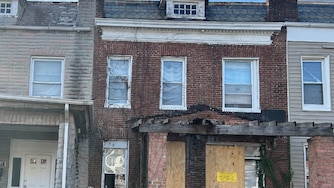When federal officials established the Beltsville Agricultural Research Center, they couldn’t have known how out of place it would feel today.
Hardly 10 miles from the White House in the middle of suburban sprawl, cows graze on a hilltop, cornstalks sway with the breeze and an agricultural library towers over fields like a giant grain elevator. Covering 6,500 acres, the Beltsville lab, known as BARC, can feel closer to America’s bucolic heartland than the Interstate 95 corridor.
The site is home to some of the U.S. Department of Agriculture’s most accomplished scientists. BARC researchers first bred a commercially available Thanksgiving turkey, in the 1940s, and soon after developed the Roma tomato.
But the crown jewel of American agricultural research may be in its final days: President Donald Trump’s administration has proposed closing it forever.
How the administration plans to shutter the lab isn’t clear.
Agriculture Secretary Brooke Rollins said in July that the USDA would transfer control of the property to the General Services Administration “over several years” but didn’t share a detailed timeline. The site bears scars from decades of deferred maintenance and experimental chemicals, and federal and state protections would complicate any attempt to sell the land.
Still, the lab’s defenders worry it would be attractive to developers.

“This is prime real estate,” Sam Droege, a federal bee scientist who spent close to 15 years working on the Beltsville campus, said during a recent visit. “You are sitting in a place that is worth billions and billions for real estate.”
Its value in over a century of scientific study is harder to measure.
‘Agriculture’s Wonderland’
The federal government first bought a 475-acre plantation near Beltsville for agricultural research in 1910, but it took until decades later, as the Dust Bowl devastated farms across the Great Plains, for BARC to resemble “Agriculture’s Wonderland,” as one newspaper put it.
The USDA expanded its Beltsville landholdings during the 1930s, and the Civilian Conservation Corps laid dozens of miles of road and constructed new buildings across the campus. By 1940, the lab covered some 12,000 acres, nearly twice its area today, creating one of the world’s largest agricultural research sites.



After announcing the USDA’s reorganization plan in July, Rollins told Fox News she wanted to move government away from D.C. and “closer to the people.” If employees don’t move, the agency will backfill positions, she said.
“This is what the Founding Fathers envisioned,” she said. “It’ll be cheaper. It’ll be more efficient, and we’ll be able to do better.”
A USDA spokesperson did not directly address emailed questions about the BARC closure but said it was a cost-saving measure in a statement. It would cost $500 million to modernize BARC and another $40 million a year to maintain operations, the statement said.
“While BARC once used to be a state-of-the-art research facility, it is no longer worth the cost to bring it into the 21st century,” said the spokesperson, who did not provide their name.
The place may lack its past sparkle, but some former USDA officials worry what closing the USDA’s largest lab would mean for the future of agricultural science.
The lab employs hundreds of scientists who have charted new ground on important issues to agricultural production, from honeybee decline and human nutrition to the uses of gene-editing CRISPR technology and pathogens in livestock.


If it closes, many talented minds will quit or retire, said Ann Bartuska, who served as deputy undersecretary and chief scientist for the USDA under President Barack Obama.
Some BARC plots have hosted experiments dating back decades, and those studies and their data could be sacrificed.
“I would consider this a very draconian move,” Bartuska said. “It’s just, ‘We’re going to get rid of this,’ without much thought to what that means.”
When a group of Maryland Democrats visited Monday, Sen. Chris Van Hollen said USDA officials seemed to skew their tour toward maintenance needs over research. Agency leaders have cited the huge costs of restoring aging buildings, but the administration hasn’t shared costs for uprooting research or replacing scientists.
BARC’s defenders understand every building can’t be refurbished, he said. “We’re trying to preserve the crown jewels.”

Easier said than done
Advocates for BARC and a neighboring federal wildlife refuge have nervously eyed encroaching developers for years, but there are other threats, too.
Under the Biden administration, officials attempted to move the country’s money-printing plant from D.C. onto 100 acres of the lab’s campus. Just a few years ago, a proposed maglev train threatened to divide BARC like a zipper on its path from D.C. to Baltimore.
Still, selling BARC wouldn’t be easy. Federal statutes protect the lab’s land and its staff.
One 1987 law, passed as President Ronald Reagan tried to shutter BARC, subjects any land sales to congressional approval. Separate legislation passed six years later by the Maryland General Assembly ensures any BARC land sold is zoned exclusively for agricultural use, according to state Sen. Jim Rosapepe, who sponsored the legislation and still represents the area.
The Beltsville closure is part of a broader USDA plan to move thousands of D.C.-area employees to other sites around the country. In its statement, the agency spokesperson said BARC research will be divided among 90-plus other labs.

Plans for several other facilities on the BARC campus are hazy. A USDA reorganization memo says the agency plans to use the newer George Washington Carver Center as temporary space for employees before it too closes. Officials also will “revisit utilization and functions” of the National Agricultural Library, a sort of Library of Congress for farm writings.
Some aren’t sure sunsetting the lab is a bad idea.
Galen Dively, a professor emeritus in the University of Maryland’s Department of Entomology, has worked on the BARC campus for decades on 600 acres leased by the university’s agricultural extension, and he’s seen how funding needs and evolution in research practices have changed things.
A lot of research today happens not on the lab’s thousands of acres but in its walled laboratories, he said. Much of the land is cultivated like a commercial farm, the professor said.
“I can see where it would be easy to shut this place down,” Dively said.
There’s also the matter of declining buildings. Some large laboratory spaces sit empty. After a whistleblower complaint exposed unsafe working conditions in BARC buildings, including flooding, asbestos and mold in one, the Biden administration allocated $50 million for improvements.

In other corners of the property, nature is reclaiming bygone buildings, including a village Droege believes was once used to quarantine animals.
Prince George’s County Councilman Thomas Dernoga, whose district includes BARC, expects state and local leaders will fight hard against closure. He’s skeptical the land is as valuable as some think because of the farmland zoning protection.
“We’re hopeful that they’re very bad at executing this,” he said.
To save the farm
The weekend after Rollins recommended closing BARC, some 200 people convened at the Greenbelt town hall for an emergency meeting.
Lab employees there worried about BARC’s fate and their futures in government, recalled Democratic Rep. Glenn Ivey, who represents Prince George’s County.
“I tell them explicitly, ‘Keep your head down, be careful about what you say and where you say it, don’t use any government email or equipment to do any communications on this,’” Ivey said.
BARC scientists seem to be largely in the dark and afraid to speak up, Droege said.
The USDA’s research arm, Agricultural Research Services, did not make scientists available for interviews. After a Banner reporter reached out to scientists directly, a top BARC official sent an email warning them not to talk.
On a Reddit forum frequented by USDA employees, commenters complained about how little information they’ve gotten from agency leaders.

Some worried in one August thread about repercussions for voicing discontent in a public comment process on the proposed reorganization. The USDA is accepting feedback on its plan through September.
At least one federal employee speaks for BARC.
Droege doesn’t work for the USDA — he runs a nearby bee lab under the U.S. Geological Survey — but he’s worked with BARC scientists for 40-plus years and grew up nearby.
BARC in some ways is a surprising target for Trump cuts, because its scientists work closely with conglomerates and pesticide companies, Droege said.
“It’s not like this is some kind of radical experiment in alternative agriculture,” he said.
For Droege, protecting BARC’s science and protecting its land go together. Driving through his old stomping grounds, he passed a sign declaring, “BARC we support you!!” and “Save our farm!”
Not far away, a maintenance employee entered the visitors center, a Great Depression-era log cabin. He wore a baseball cap bearing the message: “Make BARC Great Again.”





Comments
Welcome to The Banner's subscriber-only commenting community. Please review our community guidelines.